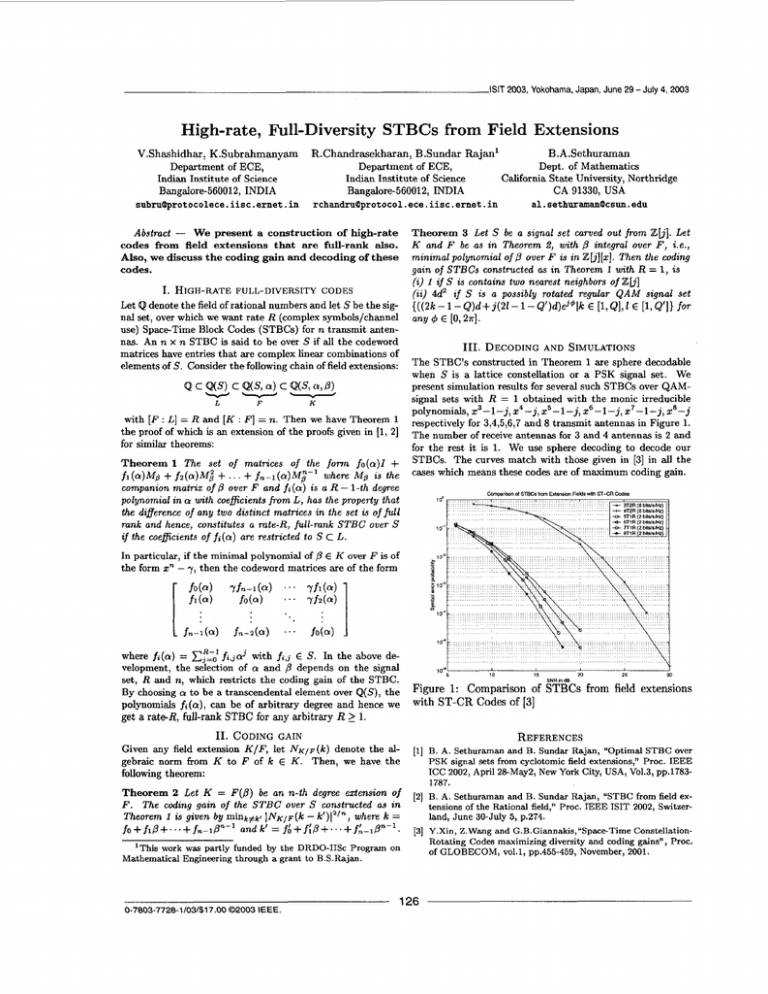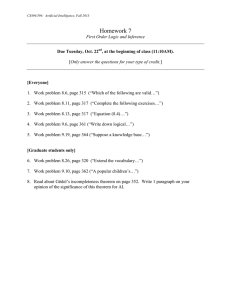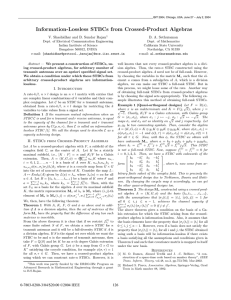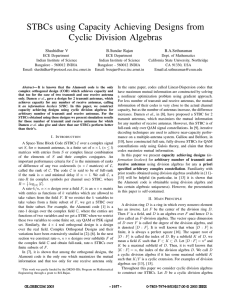Document 13732276
advertisement

ISlT 2003,Yokohama,Japan, June 29 -July 4,2003
High-rate, Full-Diversity STBCs from Field Extensions
V.Shashidhar, K.Subrahmanyam
Department of ECE,
Indian Institute of Science
Bangalore-560012, INDIA
subru@protocolece.iisc.ernet.in
R.Chandrasekharan, B.Sundar Rajan'
B.A.Sethuraman
Department of ECE,
Dept. of Mathematics
California State University, Northridge
Indian Institute of Science
Bangalore-560012, INDIA
CA 91330, USA
rchandru@protocol.ece.iisc.ernet.in
al.sethuraman@csun.edu
Abstract - We present a construction of high-rate
codes from field extensions that are full-rank also.
Also, we discuss the coding gain and decoding of these
codes.
1. HIGH-RATE
FULL-DIVERSITY CODES
Let Q denote the field of rational numbers and let S be the signal set, over which we want rate R (complex symbols/channel
use) Space-Time Block Codes (STBCs) for n transmit antennas. An n x n STBC is said to be over S if all the codeword
matrices have entries that are complex linear combinations of
elements of S. Consider the following chain of field extensions:
Theorem 3 Let S be a signal set carved out from Zb]. Let
K and F be as in Theorem 2, with /3 integral over F , i.e.,
minimal polynomial of /3 over F is in Zb][x]. Then the codang
gain of S T B C s constructed as in Theorem 1 with R = 1, is
(i) 1 if S is contains two nearest neighbors of Z[j]
(ai) 4d2 i f S is a possibly rotated regular QAM signal set
{((2k-1-Q)d+j(2Z-1-Q')d)ej61k
E [l,Q],Z E [l,Q'])
for
any q5 E [O, 274.
111. DECODING
AND SIMULATIONS
The STBC's constructed in Theorem 1 are sphere decodable
when S is a lattice constellation or a PSK signal set. We
present simulation results for several such STBCs over QAMQC
CX
?:
a! C FS,,",
signal sets with R = 1 obtained with the monic irreducible
L
F
K
polynomials, x3-i-j, x4--j, e5-1-j, e6-i-j, x7-i-j, z8-j
with [F: L] = R and [ K : F ] = n. Then we have Theorem 1 respectively for 3,4,5,6,7 and 8 transmit antennas in Figure 1.
the proof of which is an extension of the proofs given in [I, 21 The number of receive antennas for 3 and 4 antennas is 2 and
for similar theorems:
for the rest it is 1. We use sphere decoding to decode our
STBCs. The curves match with those given in [3] in all the
Theorem 1 The set of matrices of the forna f o ( a ) l
fi(cr)Mg f2(a)M;
. . . fn-l(a)M;-' where Mg is the cases which means these codes are of maximum coding gain.
companion matrix of P over F and f i ( a ) is a R - 1-th degree
Camoarismof STBCs f r m Extensan Field8 wilh ST-CR Code0
polynomial an a with coeficients from L , has the property that
the difference of any two distinct matrices in the set i s of full
rank and hence, constitutes a rate-R, full-rank S T B C over S
10-1
i f the coeficients of f i ( a ) are restricted to S C L .
Pi
+
+ +
+
In particular, if the minimal polynomial of p E K over F is of
the form xn - 7, then the codeword matrices are of the form
I
fo(4
f1(a)
Yfn-l(4
fo(a)
fn-l(a)
fn-2(0)
4
... 7flW
... rf4a)
...
...
fo(a)
where fi(a) =
fi,jaj with fi,j E S. In the above development, the selection of a and P depends on the signal
set, R and n, which restricts the coding gain of the STBC.
By choosing a to be a transcendental element over Q(S), the
polynomials fi(a),can be of arbitrary degree and hence we
get a rate-R, full-rank STBC for any arbitrasy R 2 1.
11.
REFERENCES
CODING GAIN
Given any field extension K I F , let NKIF(k) denote the algebraic norm from K to F of k E K . Then, we have the
following theorem:
Theorem 2 Let K = F ( P ) be a n n-th degree extension of
F . The coding gain of the S T B C over S constructed as in
Theorem 1 i s given by mink#kt ] N K I F ( ~k1)12/n,where k =
fo f1P
. . fn-1Dn-l and k' = fh f ; P . . f;-1Pn-'.
+
+. +
+ +. +
'This workwas partly funded by the DRDO-IISc Program on
Mathematical Engineering through a grant to B.S.Rajan.
0-7803-7728-1
103/$17.00
02003 IEEE.
[l] B. A.
Sethuraman and B. Sundar Rajan, "Optimal STBC over
PSK signal sets from cyclotomic field extensions," Proc. IEEE
ICC 2002, April 28-May2, New York City, USA, Vo1.3, pp.17831787.
[2] B. A. Sethuraman and B. Sundar Rajan, "STBC from field extensions of the Rational field," Proc. IEEE ISIT 2002, Switzerland, June 30-July 5, p.274.
[3] Y.Xin, Z.Wang and G.B.Giannakis,"SpaceTime ConstellationRotating Codes maximizing diversity and coding gains", Proc.
of GLOBECOM, vol.1, pp.455-459, November, 2001.
126





